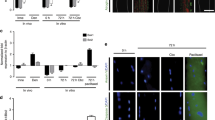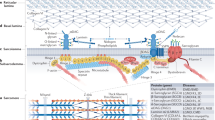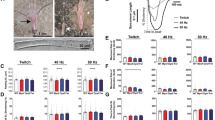Abstract
IT has been suggested that ‘functional denervation’, a failure of structurally intact neuromuscular junctions to evoke a muscle fibre action potential following nerve stimulation, plays an important part in the pathogenesis of murine muscular dystrophy1,2. Other workers, however, have been unable to confirm the existence of ‘denervated’ muscle fibres in dystrophic mouse muscle3. Moreover, the demonstration that transmitter release in response to nerve stimulation is normal in such muscle4 seems to preclude the possibility that ‘denervation’ may arise in an unpredictable or spasmodic way as a result of changes in transmitter store size or mobilisation during or after the repetitive discharge of the motoneurone. It has been considered possible, however, that the microelectrode techniques used in many of these studies do not always sample diseased muscle fibres, but select only a hypothetical group of ‘normal’ or ‘healthy’ muscle fibres. We have therefore applied a technique of intracellular staining5,6 and demonstrated that structurally abnormal muscle fibres in dystrophic muscle display normal neuromuscular transmission.
This is a preview of subscription content, access via your institution
Access options
Subscribe to this journal
Receive 51 print issues and online access
$199.00 per year
only $3.90 per issue
Buy this article
- Purchase on Springer Link
- Instant access to full article PDF
Prices may be subject to local taxes which are calculated during checkout
Similar content being viewed by others
References
McComas, A. J. & Mrozek, K. J. Neural. Neurosurg. Psychiat. 30, 526–530 (1967).
Law, P. K., Atwood, H. L. & McComas, A. J. exp. Neurol. 51, 434–443 (1976).
Harris, J. B. & Marshall, M. W. Expl Neurol. 41, 331–344 (1973).
Harris, J. B. & Ribchester, R. R. J. Physiol., Lond. 263, 118–119P (1976).
Kater, S. B. & Nicholson, C. (eds) Intracellular Staining in Neurophysiology (Karger, Basel, 1973).
Harris, J. B. & Ribchester, R. R. Br. J. Pharmac. 55, 306–307P (1975).
Martin, A. R. J. Physiol., Lond. 130, 114–122 (1955).
Karnovsky, M. J. & Roots, L. J. Histochem. Cytochem. 12, 219–221 (1964).
Michelson, A. M., Russell, E. S. & Harman, P. J. Proc. natn. Acad. Sci. U.S.A. 41, 1079–1084 (1955).
Isaacs, E. P., Bradley, W. G. & Henderson, G. J. Neurol. Neurosurg. Psychiat. 36, 813–819 (1973).
Williams, P. E. & Goldspink, G. J. Anat. 122, 455–465 (1976).
Author information
Authors and Affiliations
Rights and permissions
About this article
Cite this article
HARRIS, J., RIBCHESTER, R. Neuromuscular transmission is adequate in identified abnormal dystrophic muscle fibres. Nature 271, 362–364 (1978). https://doi.org/10.1038/271362a0
Received:
Accepted:
Published:
Issue Date:
DOI: https://doi.org/10.1038/271362a0
Comments
By submitting a comment you agree to abide by our Terms and Community Guidelines. If you find something abusive or that does not comply with our terms or guidelines please flag it as inappropriate.



